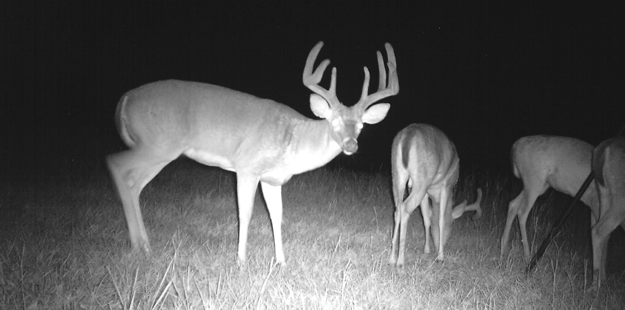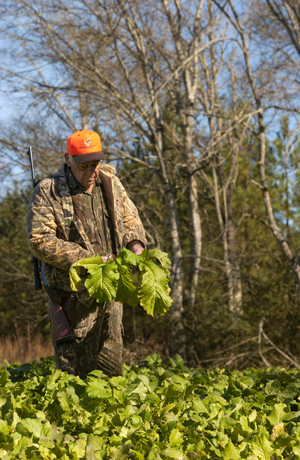
Design your own “shooter buck” formula
By Ron Jolly
The flash of white antlers brought me to full attention. The buck was less than sixty yards away and slowly making his way through the cane thicket towards my stand. I recognized him with the first clear look through my binoculars. This buck was on our “shoot list.” Numerous trail camera photos portrayed a twenty inch inside spread. My wife Tes had named him “Handle Bars” because of the width of his rack. His tine length was questionable but decent. We had estimated his beam length nineteen inches and mass near four inches at the bases. Our best body weight guess was 185 pounds. Handle Bars was now at forty yards and still moving my way. This was the first daylight look at this beautiful east-central Alabama buck. Looking through my Nikons it took only a few seconds to make a decision, I decided to leave my bow on the hook and let him walk.
Establishing a Shoot List
Tes and I are members of the Quality Deer Management Association. By the time we bought our farm we had already incorporated the four cornerstones of QDMA in our hunting philosophy; herd management, herd monitoring, habitat management and hunter management.
 Our farm is small, 210 acres, but we have great neighbors with many of the same goals. Tes and I do everything our budget allows to provide food and cover that will attract bucks and hold them during daylight hours. Corn, clover, brasicas and cereal grains are planted on twenty percent of our acreage. Bedding areas are cultivated with “hack-and-squirt” treatments with Arsenal and by thinning and burning planted pines. Another twenty acres are designated sanctuary. Trail cameras are used extensively to tract herd statistics and determine what bucks use our property and when they use it.
Our farm is small, 210 acres, but we have great neighbors with many of the same goals. Tes and I do everything our budget allows to provide food and cover that will attract bucks and hold them during daylight hours. Corn, clover, brasicas and cereal grains are planted on twenty percent of our acreage. Bedding areas are cultivated with “hack-and-squirt” treatments with Arsenal and by thinning and burning planted pines. Another twenty acres are designated sanctuary. Trail cameras are used extensively to tract herd statistics and determine what bucks use our property and when they use it.
Once we get a photograph of a buck that we think is mature we make every effort to get more photos. We name the buck and start a folder for all images taken of that buck. In that folder we keep written notes of where and when the image was captured. We also try to put “eyes” on the buck. The idea is to identify bucks that we think are at least four years old. When enough evidence suggests a certain buck is four or older we place that buck on our “shoot list.” Younger bucks are treated with the same intensity but they are designated “next year” bucks.
Trail camera photos are useful in determining a shooter buck but nothing replaces “eyes on.” It is hard to judge antler mass and body weight with trail camera photos alone. During early antler growth periods this is especially true. Velvet-covered antlers look larger than they really are and body weights are down at this time of year. Later, when velvet is gone and bucks grow their winter coat they are easier to judge in trail camera photos.
There are many different levels of QDMA. Tes and I have been fortunate to spend a lot of years hunting whitetails. Holding out for a four year old buck may be setting the bar high for some hunters. For us it made sense and turned our passion for whitetail deer into a year-round adventure.
The Formula
In an effort to shoot three-year and older bucks, Tara/Willow Point in Vicksburg, Mississippi came up with a formula that helped their hunters identify shooter bucks on their property. These are the categories used to judge bucks at Tara/Willow Point and the minimums for each category:
- Body weight---185 pounds
- Antler mass---4 inches at the base and decent mass carried throughout the rack
- Beam length---20 inches
- Tine length---Decent (7 inches plus on G2’s and G3’s)
- Antler spread---15 inches
Bobby Culberson, head guide at Tara, says that since adopting this formula they have been very satisfied with the results.
“At Tara 85% of the bucks that meet three of these five requirements are three years or older,” said Culberson. “This allows us to target an age class of bucks. If you target spread, points, body weight or a combination of these characteristics you often pass a buck that is mature but lacks enough points or spread. He has a free pass to breed and pass his genetics on. With the three-out-of-five formula we have had great success at harvesting the age class buck we target at Tara/Willow Point and letting our super two-year old bucks live another year.”
This is the formula and values that work at Tara but what about other parts of the country. Northern whitetails are larger animals and often have greater antler mass. Texas whitetails are smaller deer and often do not carry heavy antler mass. So how can the formula work for you?
At Tara/Willow Point and our farm all deer harvested are weighed and aged and the antlers are measured. We use that data to establish values for the formula. If you do not have that data for your deer there are several ways to obtain information that will get you started. The Quality Deer Management Association prints its annual Whitetail Report that is filled with information about deer from almost every state. The QDMA media room is a great source of information on almost everything whitetail. Another option is to contact a private game manager in your area. He should be able to provide information that will help you determine the values to use for deer in your area.
Customize the Formula
After hunting at Tara several times Tes and I decided to adopt the Tara formula for our farm in Alabama in 2008. That year Tes shot the only buck we killed on our farm. He met the spread, tine length and mass requirements but was short on beam length and body weight. He was three years old.
In 2009 Tes killed her Alabama three buck limit on our 210 acres. The first buck was a 210 pound eight point that scored 134, the second was a 225 pound non-typical eleven point and the third was a 225 pound eight point with a 20 ½ inch inside spread we had named “Hoss.” All three bucks were four year olds. The first buck had never been seen or photographed but trail camera photos had landed the other two bucks on our shoot list.
After the 2009 season we made the decision to let three-year-old bucks walk on our farm. With the harvest information from that year we customized the formula to our bucks. We upped the body weight to 200 pounds and in 2010 I arrowed a buck on our shoot list that grossed 146 7/8 inches. He was the only buck we shot that season. We had named him “Little Joe” because the year before he often traveled with “Hoss”. Coyotes got to this buck before I did so we did not weigh this buck but four of the five criteria were met in the rack. He was four years old!
Satisfaction Guaranteed
 Mature whitetail bucks are a mystery to many people who hunt them. They are very secretive, elusive and just plain smart. In August one of our trail cameras captured one photo of a very nice buck at a mineral lick. He had hints of kicker points on his G2’s. We never got another photo of that buck that year and never saw him. In 2009 there was no evidence of him using our farm. We assumed he had been harvested. Then in August 2010, at the same mineral lick, there he was! The hints of kicker points from 2008 had materialized into two and three inch kicker points on his G2’s and G3’s. Night after night the trail cameras gave us information of when and where this buck was using our farm. Then in mid-October he disappeared. Needless to say he was high on our shoot list.
Mature whitetail bucks are a mystery to many people who hunt them. They are very secretive, elusive and just plain smart. In August one of our trail cameras captured one photo of a very nice buck at a mineral lick. He had hints of kicker points on his G2’s. We never got another photo of that buck that year and never saw him. In 2009 there was no evidence of him using our farm. We assumed he had been harvested. Then in August 2010, at the same mineral lick, there he was! The hints of kicker points from 2008 had materialized into two and three inch kicker points on his G2’s and G3’s. Night after night the trail cameras gave us information of when and where this buck was using our farm. Then in mid-October he disappeared. Needless to say he was high on our shoot list.
The good news is that there were four other bucks on that list that never gave us an opportunity. In addition there were six bucks that we judged to three-year-olds that were regulars on the farm.
One of the toughest decisions a hunter has to make is whether or not to pull the trigger or release the arrow. In an area that rarely produces a buck that scores 150 inches it is very satisfying to know we are giving our bucks the opportunity to grow the best antlers possible. If you struggle trying to decide which buck to shoot give the Tara/Willow Point formula a try. Put in your own values for body weight, beam length, antler mass, tine length and spread. When you see a buck that meets your values in three of those five criteria, “Shoot That Buck!”
Some hunters struggle when it comes to judging a live whitetail buck. Here are some tools that will help you make the right call:
- Compare the size of the antler bases to the size of the buck’s eye. The circumference of a mature buck’s eye is approximately four inches.
- Antler width can be compared to the width of the buck’s ears. A mature buck’s ears are 16 inches when alert and 18 inches when relaxed.
- A mature whitetail buck that carries 200 pounds on our farm appears short-legged and short necked. His belly sags and his rear end appears small.
- Compare tine length to the length of the ears. From skull to tip ears are 7 inches long.
- Use the ear length to judge beam length. If the beams are three times as long as one ear his beams are 20 inches or longer.
These values may vary from region to region but they will give you an idea of what you are looking at when the moment comes. Study the deer you hunt and assign your own values to the references listed above. Soon you will be making your choice to shoot or pass with confidence.






























